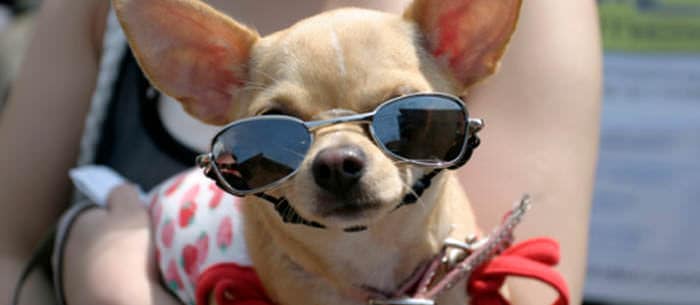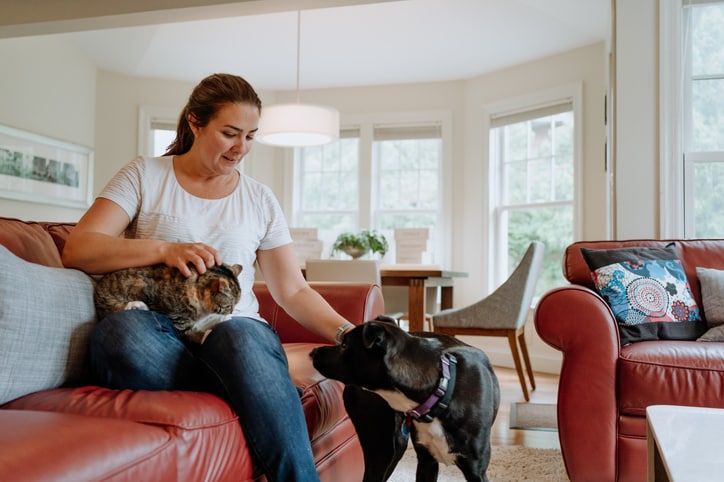Pet owners are often said to be a “breed” unto themselves. Some treat their animals as they would their kids. But while it usually comes from a place of love and can even be pretty darn cute, these habits aren’t always good.
St. Louis-based veterinarian Amy Pike and New York City dog trainer Kate Perry weigh in on how these human-like behaviors can affect your pet.
“Just like children, pets need clear boundaries and owners should have good verbal control over how they behave,” Pike says. “We often remind our clients that pets are not children because they are not verbal and will always need us to care for them, feed them and protect them.”
-
Push Pets in a Baby Carriage
We’ve all seen it: a small (or much-too-large) dog being transported around in a stroller. Cute or ridiculous?Expert’s take: Perry, who authored the book “Training for Both Ends of the Leash,” says that there’s could be a real reason for pet owners to use a stroller. “Strollers are very helpful for the older dogs with hip or health problems that can’t walk too far but still need to get out and about,” Perry says. “Same goes for the very young puppies that are in their sequence of shots, that need to be exposed to their environment without having to put paws on the ground.”
So, if you’re breaking out the pet-sized Bugaboo because your vet suggested it, great! If you’re just copying it from something you saw on perezhilton.com, stash the wheels and pick up a leash.
-
Play Dress-Up
Pets, like humans, need to be able to move and act — to an extent — independently. But every Halloween you see tons of animals dressed up in wacky costumes and every December you see the same poor pets wearing reindeer ears.Expert’s take: One-time costuming might not be so bad, but constant costuming could lead to problems. “While some dogs enjoy being dressed up, they need us to make sure they are safe and cared for by providing the structure and predictability of a good command-response relationship that shows them how to get what they need,” Pike says.
Check out these Halloween Pet Costumes: Safety Guidelines ť
-
Bring Pets Into Their Bed
No matter their size, some owners love their animals so much, they let them curl up on the bed at night.Expert’s take: There are varying opinions on this issue among pet owners and trainers, but when it comes down to it, it’s really what you and your pet are most comfortable with. If your dog has bladder issues, weak hindquarters, sheds a lot or is prone to excessive affection, it would be best to put your dog in a crate overnight or set aside a doggie bed in another area of the house.
However, if you don’t mind waking up to a furry friend in the morning, and don’t mind sharing the warmest spot in the house overnight, many trainers say go for it. It’s all about personal preference.
-
Have Conversations With Their Pet
We all know pets are capable of understanding commands and researchers have agreed animals are capable of listening to human speech. But is having actual conversations with your animal OK?Expert’s take: Most veterinarians and trainers will say it’s perfectly fine to have a conversation with your pet. In fact, researchers have found it can actually be therapeutic. So go on, talk to you dog
-
Lavish Pets With Gifts
Whether for actual holidays, birthdays or just-because, owners often try to find a way to show their pet how much they care by purchasing gifts.Expert’s take: Pike says that the best way to show your affection is to actually spend time with your dog. Just as with kids, treats and toys do not equal love. Remember, a pet should only be rewarded when it does something worth rewarding.
-
Feed Pets From the Kitchen Table
Many families feed their animals from the kitchen table during family meals.Expert’s take: Both Pike and Perry agree this is behavior that needs to be corrected, as it could have negative effects on your pet. Perry says, “Feeding at the table teaches unwanted behavior from the [pet] and often leads to mixed messages of leadership.” Certain human foods can actually be harmful to an animal’s digestive system as well. While there are some human foods that are OK for a dog to eat — real meat, yogurt, rice, broccoli — it’s important to have a set time and place for your animal to eat that’s not your family’s meal time. Curb your pet’s begging by placing him in another room while you eat.
Pets are often looked upon as a part of the family and sometimes afforded human-like treatment. At times, this is OK, other times the behavior should be changed sooner than later for the benefit of you and your pet.
Jennifer Eberhart is a freelance writer in New York. Her work can be found here.


